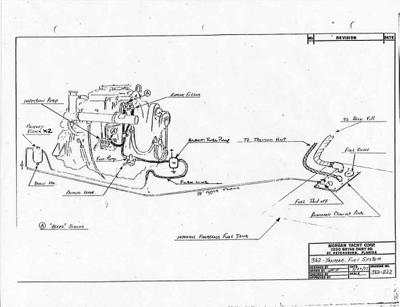schlepper
John m. Harrison
I was readying to head out early this afternoon for a day of sailing with another couple who stayed on the boat with us last night.
I opened the throttle about 1/4", pushed in the shutoff nob, turned the key and it started right up. It was overrevving a bit so i pulled the throttle back and it shutoff. I could not get it running again. I have always been told if a diesel won't run it's likely bad fuel, no fuel or air in the fuel. I had drained off about 1/8-1/4" of fuel from my Racor 500 and found some junk but no water last weekend but have run it since then several times, no problem. Ichecked for leaks in the system, found none. So i commenced to bleed the filter on the engine. Made a mess but it had some air bubbles. Used manual lift pump, then i went to injector pump, loosened bleed valve on side of pump, no bubbles, still wouldnt start. Loosened injectors at 2,3&4, fuel drops were coming out, retightened, still won't start. Ran out of time.
I've changed fuel filters on Mercedes benz 300 which has a similar engine filter, have never had a problem like this? The fuel tank is 3/4 full and no samples show water or other contaminant issues.
Am i missing something simple here?! I also cannot find anywhere there is an air leak. I suspect partially draining the racor caused this. I did take the top off the racor and it took about half a SOLO cup of fuel. The accessibility is poor making doing anything much more of a headache to do anything.
I opened the throttle about 1/4", pushed in the shutoff nob, turned the key and it started right up. It was overrevving a bit so i pulled the throttle back and it shutoff. I could not get it running again. I have always been told if a diesel won't run it's likely bad fuel, no fuel or air in the fuel. I had drained off about 1/8-1/4" of fuel from my Racor 500 and found some junk but no water last weekend but have run it since then several times, no problem. Ichecked for leaks in the system, found none. So i commenced to bleed the filter on the engine. Made a mess but it had some air bubbles. Used manual lift pump, then i went to injector pump, loosened bleed valve on side of pump, no bubbles, still wouldnt start. Loosened injectors at 2,3&4, fuel drops were coming out, retightened, still won't start. Ran out of time.
I've changed fuel filters on Mercedes benz 300 which has a similar engine filter, have never had a problem like this? The fuel tank is 3/4 full and no samples show water or other contaminant issues.
Am i missing something simple here?! I also cannot find anywhere there is an air leak. I suspect partially draining the racor caused this. I did take the top off the racor and it took about half a SOLO cup of fuel. The accessibility is poor making doing anything much more of a headache to do anything.


